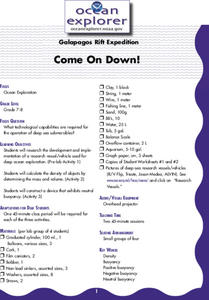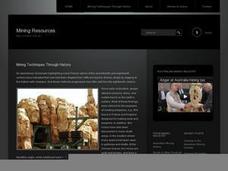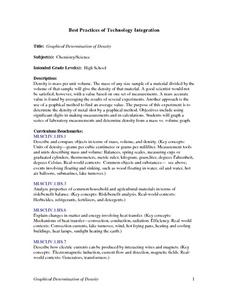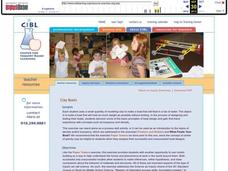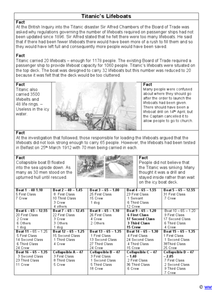Curated OER
Galapagos Rift Expedition Come On Down!
Students research the development and implementation of a research vessel/vehicle used for deep ocean exploration. In this oceanography lesson, students calculate the density of objects by determining the mass and volume.
Curated OER
Water Density and Stability Lab
Students observe how different water densities and salinity control the depth at which different water masses occur. Submarines are used as a case study. This is a well-designed with an excellent worksheet.
Curated OER
Froth Flotation
Sixth graders experiment with the froth flotation process to extract metallic ore by using basic chemicals and equipment in the science classroom.
Curated OER
How Dense Are You?
Students examine how density is a value that describes what type of a material an object is made of regardless of its shape or size.
Curated OER
Feeding Frenzy
Learners are divided into two teams in which its members are to gather as many objects in the pool as possible gaining points for different objects.
Curated OER
Graphical Determination of Density
Learners determine the density of metal shot by a graphical method using significant digits in making measurements and calculations. Students graph a seris of laboratory measurements and determine density from a mass verses volume graph.
Curated OER
Clay Boats
Seventh graders are given the opportunity to use model-building as a way to help comprehend the forces and phenomena at work in the world around them. They use both successful and unsuccessful models to make inferences, refine...
Curated OER
What Animals Live in the Rice Paddy?
Students listen to a story about turtles leaving a rice field to go to sea. For this literacy and social science lesson, students discuss the story, write a sentence describing each turtle, and draw a picture of the turtle's home in the...
Curated OER
Physical Properties Of Coal
Students examine and identify the observable properties of coal. After a lecture/demo, students perform a simple experiment. They observe samples of coal and record data in an organized manner.
Curated OER
#24 Rotating Frames of Reference in Space and on Earth
Learners explore rotating frames of reference, focusing on the weightless environment in space and the Coriolis force.
Curated OER
Let's Catch Some Dirt From the Air
Students create "catchers" that collect dirt particles from the air. They observe the particulate matter that is collected from the air and discuss the effects and causes of air pollution.
Curated OER
Estuarine Currents
Students explore an estuarine system to gather data on density driven currents. This type of current is contrasted with temperature and wind driven currents.
Curated OER
Get the Dirt
Students investigate a variety of soil samples placed in cold water jars. Layers of soil are examined for the difference between organic matter and rock fragments.
Curated OER
"The Bridge"
Students read poem, "The Bridge," by Henry Wadsworth Longfellow, discuss how they are connected to other human beings, both past and present, and create time capsules including their favorite memorabilia.
Curated OER
Wetlands/Watershed Model
Pupils work together to create a watershed model. They discover the flow of surface water on different topography. They examine how materials originate from miles away and end up in a different wetland.
Curated OER
Water Density
Students identify and analyze the concept of density using the formula, density equals mass divided by volume. They review the differences in salinity levels of the ocean and note that the changes in density are caused by wind and...
Curated OER
Volumw Measurement, English System
Eighth graders biew each volume container and discuss where they have seen them in their home, and how they have seen them used. They explore the different names of volume sizes and their equivalents towards one another. Students...
Curated OER
Uses of Pumice
In this pumice learning exercise, students read about how pumice if formed and the different uses of pumice. Then students complete 4 short answer questions
Curated OER
Match Opposite Pairs
In this antonyms instructional activity, students read the ten words in a column and add a missing letter to a word in a second column that will make an antonym.
Curated OER
Titanic's Lifeboats
In this Titanic's lifeboats learning exercise, students read about the specific numbers of people on the lifeboats of the Titanic. Students answer 10 questions about the text.
Curated OER
How Do We Breathe?
Students study the structure of the lungs. In this lung structure lesson, students use lung models to study the structure of lungs and experiment to measure the amount of air in the lungs.
Other popular searches
- Sink Float Buoyancy
- Sink Float Lessons
- Float or Sink
- Float Sink Float
- Sink Float Sink
- Fruit Sink Float
- Sink Float Song
- Float and Sink
- Sink Float Explanations
- Sink and Float Bubbles
- Sink Float Submerge
- Sink or Float Experiment


